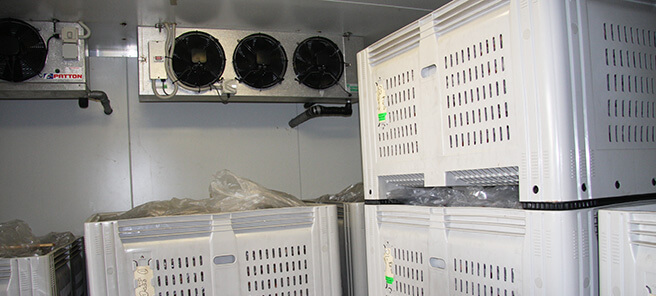Using CO2 as a refrigerant gas can reduce energy consumption and increase cool room efficiency.
Refrigeration plant is generally a mature technology. Several refrigerants are in common use including R22 (being phased out due to its ozone depleting potential), R134a and R404a.
Although the refrigerants R134a and R404a do not significantly affect ozone depletion they have high global warming potentials (GWPs) of 1,300 and 3,260 CO2-e respectively. From 1st July 2012 synthetic refrigerant are taxed using the current carbon price and the above GWPs.
Perhaps surprisingly, CO2 itself has negligible greenhouse gas impact compared to synthetic refrigerants. As it has excellent heat transfer properties, smaller evaporator and condenser systems can be used to provide similar cooling to synthetic refrigerants. The drawbacks are a currently lower coefficient of performance (COP), mainly due to the less developed compressor technology, as well as its higher pressures needed which increase system cost.
CO2 has been used as a refrigerant for decades, but demand has only recently increased due to issues with synthetic refrigerants. It is increasingly used in Europe and there are some limited examples of its use in Australia, but apparently none in the vegetable industry.
Note that the CO2 system does not release CO2 into the cool room, it is contained within the sealed refrigeration system.
Comparison of refrigeration costs
Growers thinking of investing in new refrigeration plant will most likely compare the cost of continuing with their current system compared to the total cost of new equipment. The example shown below compares the net present value of three refrigeration plants; a paid off plant running on R134a, a new plant running on R134a and a new plant running on CO2.
| R134a new plant |
R134a paid off |
CO2 new plant |
||||
| min | max | min | max | min | max | |
| Total plant cost ($/kW_e) | 500 | 1,000 | - | - | 550 | 1,250 |
| Coefficient of performance (refrigerating power per unit of electrical energy) | 3.0 | 2.5 | 2.5 | 2.0 | 2.5 | 2.0 |
| Refrigerant price ($/kg) | 50 | 100 | 50 | 100 | 10 | 50 |
| Refrigerant price with carbon tax ($/kg) NB Although price rises have been blamed on the carbon tax, this is a contentious issue with some refrigerant suppliers accused of price gouging) |
80 | 130 | 80 | 130 | 10 | 50 |
| Total plant cost including refrigerant ($/kW_e) | 580 | 1,108 | 67 | 87 | 558 | 1,283 |
| Electricity price ($/MWh) | 200 | 300 | 200 | 300 | 200 | 300 |
| Capacity factor (power consumed by the plant compared to its rated maximum capacity) | 20% | 25% | 20% | 25% | 20% | 25% |
| Annual electricity costs ($ per kW_e/year) | 438 | 657 | 438 | 657 | 350 | 657 |
| Leakage rate (%/year) NB. Leakage of 10-15% is common, but a well maintained plant should leak less than this. |
0 | 30 | 0 | 30 | 0 | 30 |
| Leakage costs ($ per kW_e/year) | 0 | 32 | 0 | 26 | 0 | 10 |
| FOM | 25 | 25 | 25 | 25 | 25 | 25 |
| Total annual running cost ($ per kW_e/year) | 463 | 714 | 463 | 708 | 375 | 692 |
| Discount rate | 0.05 | 0.1 | 0.05 | 0.1 | 0.05 | 0.1 |
| Total net present value ($ per kW_e) | 5,306 | 6,434 | 4,806 | 5,385 | 4,447 | 6,517 |
This analysis shows that the paid-off R134a plant is likely to cost in the order of $5,096/kW_e compared to $5,870/kW_e for a new R134a plant or $5,482/kW_e for a new CO2 plant. However, if the CO2. plant is able to achieve a lower capacity factor due to its better heat transfer, it may already be the most cost effective option. Although a new CO2 plant is currently 10-25% more expensive than a new R134a plant, this difference is likely to disappear within the next 15 years.
Importantly, refrigerant replacement represents a small component of total cost in all cases, even if R404a (with its higher global warming potential) is used and leakage rates were up to 30%. Electricity accounts for more than 80% of operating costs. Plant costs are secondary, with refrigerant replacement, operating and maintenance together accounting for roughly 10% of net present value.
A lesser known feature of CO2 based refrigeration is that it has a high temperature of heat rejection – roughly 120ºC. Recovering this waste heat may be useful, especially if large quantities of hot water are required to, for example, heat a greenhouse or manufacture a processed product. The financial viability of a CO2 based refrigeration plant is significantly improved if such waste heat can be used on-site.
As CO2 plant improves it will become a better option. Modelling for 2030 indicates that by then this technology will outperform synthetic refrigerants. Again, this is not because of the carbon price, but rather because of savings in electricity costs.
